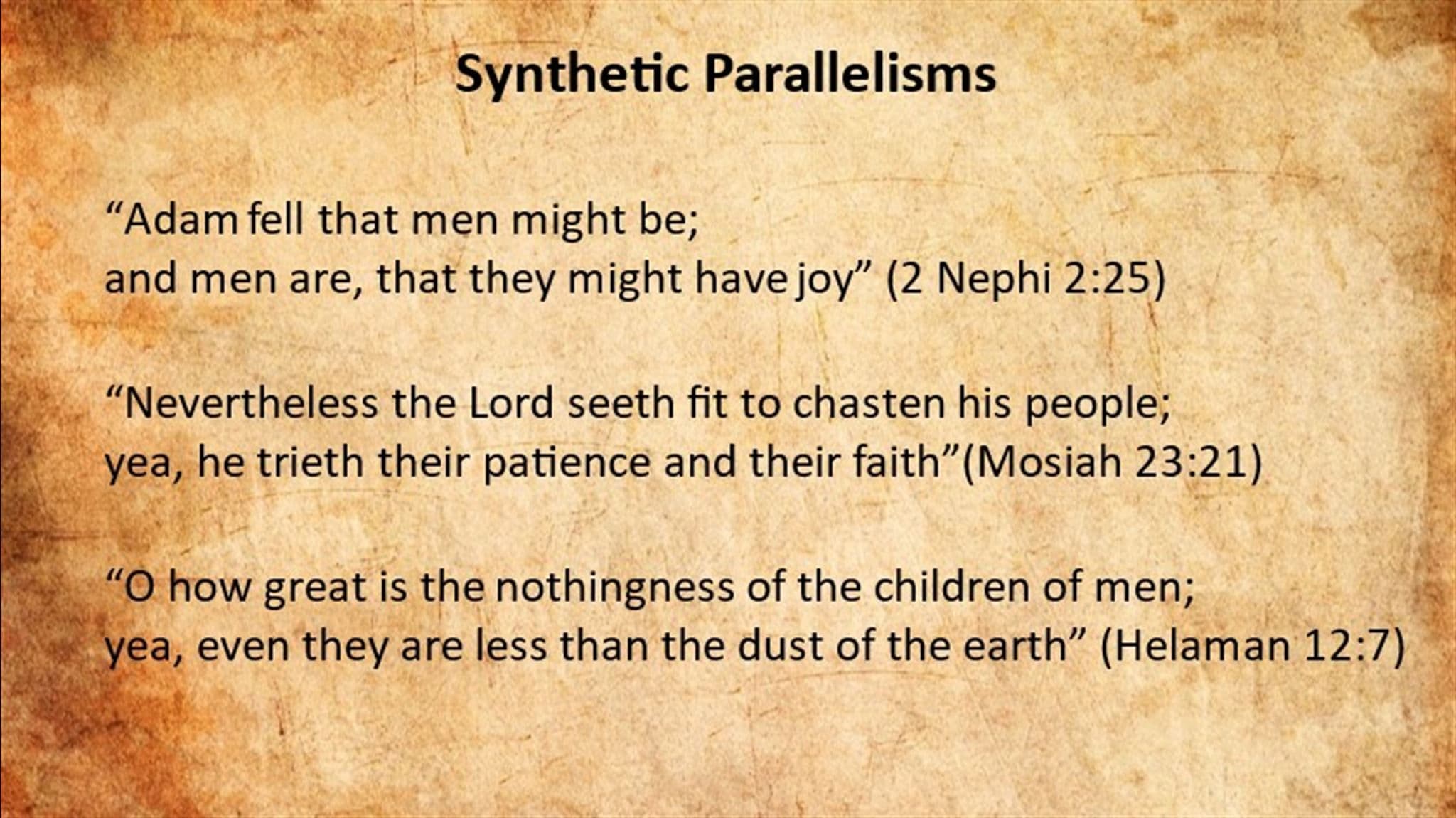Evidence #283 | December 13, 2021
Book of Mormon Evidence: Synthetic Parallelisms
Post contributed by
Scripture Central

Abstract
The Book of Mormon features a number of synthetic parallelisms which help establish the text’s literary complexity and Hebrew origins.Synthetic Parallelisms
Synthetic parallelism involves two lines of text, wherein the second line in some way completes, complements, adds to, explains, or otherwise finishes the thought presented in the first line. As explained by Hebrew scholar Donald Parry, “It is called synthetic because a synthesis, or coordination between the two elements takes place.”1 Here is an example from Proverbs 1:7:
The fear of the Lord
Is the beginning of knowledge.
Compared to parallelisms involving synonymous or antithetical elements, synthetic “parallelism is looser and the corresponding terms do not line up as neatly.”2 Yet this doesn’t mean it is completely without structure. “Synthetic parallelism tends to favor a word-unit balance between the two lines, creating equality between both phrases of the parallelism.”3
Unfortunately, when it comes to the Bible, this balance is often difficult to detect unless one is familiar with the underlying text.4 This same challenge is surely present in the Book of Mormon, as we only have the text in its English translation. Still, the identification of synthetic structures is not completely out of the question. A number of proposed examples have been identified in the Nephite record, as shown in the following passages:
Adam fell that men might be;
and men are, that they might have joy.
Nevertheless the Lord seeth fit to chasten his people;
yea, he trieth their patience and their faith.
O how great is the nothingness of the children of men;
yea, even they are less than the dust of the earth.
Extended Synthetic
A more complex variety of the same parallelism, called extended synthetic, “consists of two or more simple synthetic parallelisms, connected together within a passage or collection of verses. Each of the parallelisms are bound together by a common theme.”5 This type of structure can be seen in Psalm 19:7–9:
The law of the Lord is perfect,
converting the soul:
the testimony of the Lord is sure,
making wise the simple.
The statutes of the Lord are right,
rejoicing the heart:
the commandment of the Lord is pure,
enlightening the eyes.
The fear of the Lord is clean,
enduring for ever:
the judgments of the Lord are true
and righteous altogether.
The synthetic unity in this series of couplets comes from similar subjects (the law, testimony, statutes, commandment, fear, and judgments of the Lord) that all have similarly favorable attributes (being perfect, sure, right, pure, clean, and true) and which all result in various related benefits. At least one example of extended synthetic can be found in the Book of Mormon, as seen in this series of woes in 2 Nephi 9:31–38:
And wo unto the deaf that will not hear;
for they shall perish.
Wo unto the blind that will not see;
for they shall perish also.
Wo unto the uncircumcised of heart,
for a knowledge of their iniquities shall smite them at the last day.
Wo unto the liar,
for he shall be thrust down to hell.
Wo unto the murderer who deliberately killeth,
for he shall die.
Wo unto them who commit whoredoms,
for they shall be thrust down to hell.
Yea, wo unto those that worship idols,
for the devil of all devils delighteth in them.
And, in fine, wo unto all those who die in their sins;
for they shall return to God, and behold his face, and remain in their sins.
Conclusion
While not as pervasive or complex as some other parallelisms, the instances of synthetic structures of the Book of Mormon add to its literary complexity and help affirm its Hebrew literary origins.
Donald W. Parry, Preserved in Translation: Hebrew and other Ancient Literary Forms in the Book of Mormon (Salt Lake City, UT: Deseret Book; Provo, UT: BYU Religious Studies Center, 2020), 23–26.
Carl J. Cranney, “The Deliberate Use of Hebrew Parallelisms in the Book of Mormon,” Journal of Book of Mormon Studies 23, no. 1 (2014): 140–165.
Donald W. Parry, Poetic Parallelisms in the Book of Mormon: The Complete Text Reformatted (Provo, UT: Neal A. Maxwell Institute for Religious Scholarship, 2007).
Donald W. Parry, “Hebraisms and Other Ancient Peculiarities in the Book of Mormon,” in Echoes and Evidences of the Book of Mormon (Provo, UT: FARMS, 2002), 155–189.
Hugh J. Pinnock, Finding Biblical Hebrew and Other Ancient Literary Forms in the Book of Mormon (Provo, UT: FARMS, 1999).
Synthetic Parallelisms
2 Nephi 2:25
2 Nephi 3:15
2 Nephi 4:35
2 Nephi 9:31–37
2 Nephi 33:1
Jacob 5:2
Mosiah 23:21
Helaman 12:7
Moroni 8:17
- 1. Donald W. Parry, Poetic Parallelisms in the Book of Mormon: The Complete Text Reformatted (Provo, UT: Neal A. Maxwell Institute for Religious Scholarship, 2007), xxiv.
- 2. N. H. Ridderbos and H. M. Wolf, “Hebrew Poetry,” in The International Standard Bible Encyclopedia, ed. G. W. Bromiley (Grand Rapids: Eerdmans, 1979), 3:893; as cited in Parry, Poetic Parallelisms in the Book of Mormon, xxiv.
- 3. Parry, Poetic Parallelisms in the Book of Mormon, xxiv.
- 4. Parry, Poetic Parallelisms in the Book of Mormon, xxiv.
- 5. Parry, Poetic Parallelisms in the Book of Mormon, xxiv–xxv.